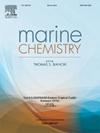涠洲岛浅海礁海洋酸度、CO2通量和代谢率的动态:浮标观测研究
IF 2.5
3区 地球科学
Q2 CHEMISTRY, MULTIDISCIPLINARY
引用次数: 0
摘要
钙化和生产的代谢过程是环境变化如何影响珊瑚礁健康的关键指标。以往的研究表明,短期内净生态系统生产(NEP)主要驱动净生态系统钙化(NEC)。然而,这两种碳代谢之间的功能关系仍然知之甚少。采用系泊浮标法,连续37天同步获取涠洲岛某珊瑚礁海域海水pH、文石饱和状态、CO2通量和碳代谢率的高频数据。我们的研究结果显示,NEC和NEP在昼夜周期和日常时间尺度上都有很强的线性相关性——即使只分析夜间时段,这种关系也成立。这表明碳代谢之间的内在联系可以独立于光而运作。此外,我们观察到主要为负的每日NEC和NEP值,表明在研究的珊瑚礁中持续的净CaCO3溶解和净异养超过数周。我们的研究结果表明,CaCO3溶解更可能发生在异养条件下的水域,这意味着异养有助于CaCO3溶解。这种紧密耦合可以用碳酸盐临界阈值(CCT)机制来解释。我们的研究强调了环境呼吸在驱动珊瑚礁生态系统尺度CaCO3溶解中的重要性,特别是在低活硬珊瑚覆盖的珊瑚礁中。这一过程将碱度释放到海水中,有助于中和呼吸引起的酸化。此外,我们确定了较高的呼吸二氧化碳释放率是所研究珊瑚礁二氧化碳排放的主要驱动因素。本文章由计算机程序翻译,如有差异,请以英文原文为准。
Dynamics of ocean acidity, CO2 fluxes and metabolic rates on a shallow reef of Weizhou Island: a buoy-based observational study
The metabolic processes of calcification and production serve as crucial indicators of how environmental changes impact reef health. Previous studies suggest that Net Ecosystem Production (NEP) primarily drives Net Ecosystem Calcification (NEC) in the short-term. However, the functional relationship between these two carbon metabolisms remains poorly understood. We employed a mooring buoy approach to obtain simultaneous, high-frequency data of seawater pH, aragonite saturation state, CO2 fluxes, and carbon metabolic rates over a coral reef on Weizhou Island for 37 consecutive days. Our findings revealed a strong linear correlation between NEC and NEP across both diel cycles and day-to-day timescales—this relationship held even when analyzing nighttime periods alone. This indicates an intrinsic link between carbon metabolisms that can operate independently of light. Furthermore, we observed predominantly negative daily NEC and NEP values, indicating persistent net CaCO3 dissolution and net heterotrophy across the studied reef for over weeks. Our results suggest that CaCO3 dissolution is more likely to occur in waters with heterotrophic conditions, implying that heterotrophy contributes to CaCO3 dissolution. This tight coupling could be explained by reef sediment dissolution through the Carbonate Critical Threshold (CCT) mechanism. Our study highlights the significance of ambient respiration in driving reef ecosystem-scale CaCO3 dissolution, especially in reefs with low live hard coral coverage. This process releases alkalinity into the seawater, helping to neutralize respiration-induced acidification. Additionally, we identified a higher rate of respiratory CO₂ release as the primary driver of CO2 emissions from the studied reef.
求助全文
通过发布文献求助,成功后即可免费获取论文全文。
去求助
来源期刊

Marine Chemistry
化学-海洋学
CiteScore
6.00
自引率
3.30%
发文量
70
审稿时长
4.5 months
期刊介绍:
Marine Chemistry is an international medium for the publication of original studies and occasional reviews in the field of chemistry in the marine environment, with emphasis on the dynamic approach. The journal endeavours to cover all aspects, from chemical processes to theoretical and experimental work, and, by providing a central channel of communication, to speed the flow of information in this relatively new and rapidly expanding discipline.
 求助内容:
求助内容: 应助结果提醒方式:
应助结果提醒方式:


